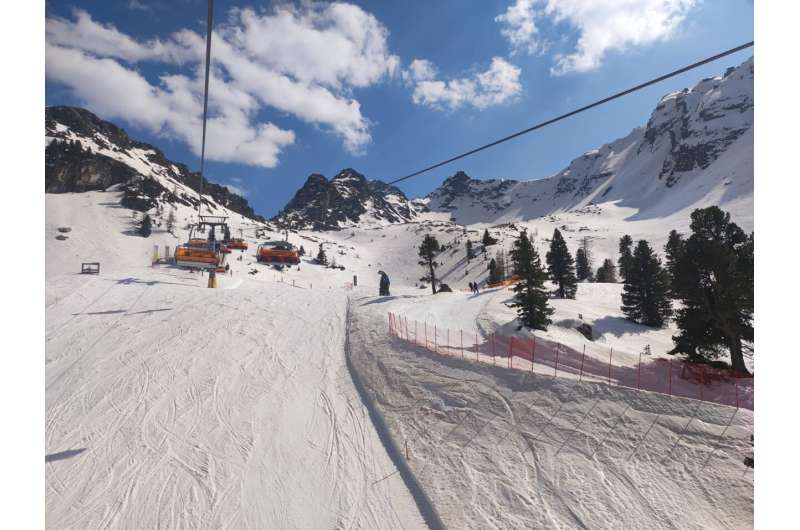This article has been reviewed according to Science X's editorial process and policies. Editors have highlighted the following attributes while ensuring the content's credibility:
fact-checked
trusted source
proofread
PFAS 'forever chemicals' being spread on world's ski slopes, study reveals

Skiers keen for slick runs are leaving toxic PFAS "forever chemicals" behind on ski slopes, research by The James Hutton Institute in Aberdeen and the University of Graz in Austria has revealed.
Fourteen different types of the chemical, commonly used in ski wax, were found in soils at family skiing spots in the Austrian Alps at levels far higher than in areas not normally used for skiing.
The study's results come just weeks after a ban on use of PFAS in ski-wax in professional skiing events came into force, because of its links with serious health concerns including cancer, fertility issues and liver damage. The work is published in the journal Environmental Science: Processes & Impacts.
Viktoria Müller, the researcher at The James Hutton institute leading the study as part of her Ph.D. research at the University of Graz in Austria, says, "These chemicals are called forever chemicals because they will need hundreds of years to break down. Because of this, they could accumulate or spread into the wider environment, including groundwater systems, which is the main concern.
"While there has been concern about the use of PFAS in ski wax for some time, this study on Alpine ski slopes showed that skiing will produce orders of magnitude higher concentrations of PFAS onto anywhere skiing is taking place where these types of wax area used.
"However, even where there is no skiing, there are still small detections because of how widely this chemical has now spread in the environment."
The study looked for around 30 of the most likely PFAS compounds expected to be found in ski wax. The study also tested six commercially available ski waxes bought in 2021, before the ban of fluoro-wax for PFAS content. Of the six, five contained fluorinated compounds.
While a number of international skiing bodies have banned use of ski waxes containing PFAS, its enforcement only recently started happening in international events due to the time it took to create suitable testing methods.
The first skier to be caught with PFAS on their skis was a two-time Olympic medalist who was disqualified following a race in late October during the Alpine World Cup in Austria.
PFAS is a man-made group of more than 12,000 chemicals, first used in the 1940s, widely used in household products from frying pans to waterproof jackets.
It has also become so widespread, and can be transported through the atmosphere, that there are background levels of it found around the world with recent studies worldwide finding these chemicals in a range of unexpected places, such as bottled water.
Concerns around its links to health issues have led to calls for bans on the use of PFAS and, to date, a number have been banned, while research is ongoing to find alternatives that can breakdown more easily.
More information: Viktoria Müller et al, Per and polyfluoroalkylated substances (PFAS) target and EOF analyses in ski wax, snowmelts, and soil from skiing Environmental Science: Processes & Impacts (2023) DOI: 10.1039/D3EM00375B
Provided by The James Hutton Institute





















